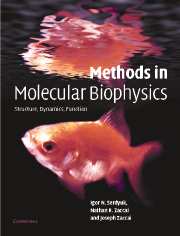Book contents
- Frontmatter
- Contents
- Foreword by D. M. Engelman
- Foreword by Pierre Joliot
- Preface
- Introduction: Molecular biophysics at the beginning of the twenty-first century: from ensemble measurements to single-molecule detection
- Part A Biological macromolecules and physical tools
- Part B Mass spectrometry
- Part C Thermodynamics
- Part D Hydrodynamics
- Chapter D1 Biological macromolecules as hydrodynamic particles
- Chapter D2 Fundamental theory
- Chapter D3 Macromolecular diffusion
- Chapter D4 Analytical ultracentrifugation
- Chapter D5 Electrophoresis
- Chapter D6 Electric birefringence
- Chapter D7 Flow birefringence
- Chapter D8 Fluorescence depolarisation
- Chapter D9 Viscosity
- Chapter D10 Dynamic light scattering
- Chapter D11 Fluorescence correlation spectroscopy
- Part E Optical spectroscopy
- Part F Optical microscopy
- Part G X-ray and neutron diffraction
- Part H Electron diffraction
- Part I Molecular dynamics
- Part J Nuclear magnetic resonance
- References
- Index of eminent scientists
- Subject Index
- References
Chapter D2 - Fundamental theory
from Part D - Hydrodynamics
Published online by Cambridge University Press: 05 November 2012
- Frontmatter
- Contents
- Foreword by D. M. Engelman
- Foreword by Pierre Joliot
- Preface
- Introduction: Molecular biophysics at the beginning of the twenty-first century: from ensemble measurements to single-molecule detection
- Part A Biological macromolecules and physical tools
- Part B Mass spectrometry
- Part C Thermodynamics
- Part D Hydrodynamics
- Chapter D1 Biological macromolecules as hydrodynamic particles
- Chapter D2 Fundamental theory
- Chapter D3 Macromolecular diffusion
- Chapter D4 Analytical ultracentrifugation
- Chapter D5 Electrophoresis
- Chapter D6 Electric birefringence
- Chapter D7 Flow birefringence
- Chapter D8 Fluorescence depolarisation
- Chapter D9 Viscosity
- Chapter D10 Dynamic light scattering
- Chapter D11 Fluorescence correlation spectroscopy
- Part E Optical spectroscopy
- Part F Optical microscopy
- Part G X-ray and neutron diffraction
- Part H Electron diffraction
- Part I Molecular dynamics
- Part J Nuclear magnetic resonance
- References
- Index of eminent scientists
- Subject Index
- References
Summary
Historical review
1845
G. Stokes showed that the translational friction for a sphere is proportional to its radius, and to the viscosity of its surrounding solvent. In 1856 he demonstrated that for small angular velocity the rotation of the sphere may be characterised by a single parameter, which is proportional to the linear dimensions cubed.
1893
D. Edwardes calculated two frictional coefficients of the rotation for an ellipsoid of revolution: one for rotation around the axis of revolution and another for rotation around a direction normal to the first. In 1906 A. Einstein showed that rotation of the sphere in Stokes' approximation may be characterised by a single constant which has the dimensions of time. In 1928 R. Gans used the Edwardes frictional coefficients for an ellipsoid of revolution to calculate the ratios of the principal relaxation times to the relaxation time of a sphere of equal volume. In 1936 F. (Francis) Perrin presented equations that give the three rotational coefficients and three rotational relaxation times as functions of the dimensions of a three-axis ellipsoid. These equations could not be expressed in terms of elementary functions. In 1960 L. D. Favro showed that diffusion coefficients related to the rotational motion of a general particle involve five relaxation times; when two of the diffusion coefficients are equal the number of relaxation times is reduced to three. In 1977 E. Small and I. Isenberg solved Perrin's equations for the rotational diffusion of a general ellipsoid using a numerical integration procedure.
Information
- Type
- Chapter
- Information
- Methods in Molecular BiophysicsStructure, Dynamics, Function, pp. 268 - 317Publisher: Cambridge University PressPrint publication year: 2007
